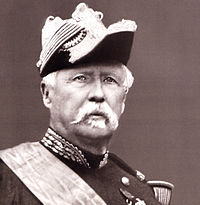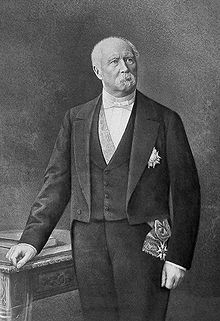Patrice de Mac-Mahon
Marie Edme Patrice Maurice, Count of Mac-Mahon , since 1859 Duke of Magenta (born June 13, 1808 at Sully Castle , † October 17, 1893 at the Château de la Forest near Montcresson ), was a French military and statesman , Marshal of France and second President of the Third Republic .
Operations in Africa
Mac-Mahon came from the old Irish Mac-Mahon family , who emigrated to France after the fall of the Stuarts . Originally, he was supposed to begin the career of a clergyman, but entered the Saint-Cyr War School in 1825 and then as a Sous-lieutenant in the General Staff School. He left this in 1830 and became a lieutenant in the 4 e régiment de hussards (4th hussar regiment ).
As a captain he was transferred to Africa . There he distinguished himself on the expedition to Algiers . Back in France, he took part in the siege of Antwerp in 1832 as adjutant to Général Achard . He then served as an adjutant in 1837 at Général Damrémont in Algeria , where he was wounded in the Constantine storm . In 1840 he served under Général Changarnier . Because of his bravery he was promoted to Chef d'escadron and in October 1840 was given command of the 10th battalion of the newly established Chasseurs d'Orléans (hunters on foot).
In 1842 he was Lieutenant-Colonel of 2 e régiment étranger d'infantry (2 regiment of Fremdenlegion ). In 1845 he was promoted to colonel and took over as commander of the 41 e régiment d'infanterie de ligne (41st line infantry regiment). In June 1848, under the republic, he was appointed général de brigade at the disposal of the governor general of Algeria . He was entrusted with the administration of the province of Oran and later the province of Constantine . In this position Mac-Mahon gained recognition and was promoted to Général de division in a victorious expedition as commander of the Constantine division in 1852 and then appointed "Inspecteur général d'infanterie" (Inspector General of Infantry).
On March 14, 1854, Mac-Mahon married Elisabeth Charlotte Sophie de La Croix de Castries (born February 13, 1834 in Paris; † February 20, 1900 there).
Crimean War
In 1855 Mac-Mahon returned to France and received command of the "1 er division d'infanterie" (1st Infantry Division) in the 1st Corps of the Northern Army. Soon after, he was transferred to Bosquets II Corps, which fought in the Crimean War. He arrived before Sevastopol in time to lead the victorious assault on Fort Malakov on September 8th. There he is said to have used the famous saying “J'y suis, j'y reste” (“I'm there, I'll stay there”).
Because of his military services to Malakov, he was awarded the title of senator. In addition, he was offered a command in the French army. However, he refused and went back to Algeria (see French North Africa ). After he had fought as a division commander against the Kabyle in 1857 , in 1858 he was given supreme command of the colony's land and naval forces.
Sardinian war
Mac-Mahon commanded the II Army Corps in the Sardinian War . There he was decisive for victory in the Battle of Magenta (June 4, 1859) with his timely attack on the right flank of the Austrians. While still on the battlefield, he was promoted to Maréchal de France ( Marshal of France ) and made Duke of Magenta . He also took part successfully in the Battle of Solferino (June 24, 1859).
Thereupon he commanded the 2nd Army Division in Lille and in 1864 succeeded Pélissier as Governor of Algeria .
Franco-German War
In the Franco-Prussian War in 1870, Mac-Mahon was given command of the 1st Army Corps with headquarters in Strasbourg . When Napoleon III. gave up his plans of attack, Mac-Mahon went back to Zabern , took a division of the VII Corps from Félix-Charles Douay and after the battle of Weissenburg (August 4th) took a good defensive position at Wörth . Here he fought the bloody battle near Wörth with great bravery , but was defeated and forced to retreat. This eventually degenerated into wild flight, as Mac-Mahon's persistent attempts to repel the enemy had exhausted the last of his troops. Mac-Mahon gathered the remains of his corps behind the Vosges , the natural obstacles of which he had neglected to use. Then he led them with great speed to Châlons-en-Champagne , where he was in command of the scattered parts of Corps I, V and VII and the newly formed XII. Corps fell.
He received the order from the reign in Paris to set off for Metz with this army of about 120,000 men in order to relieve the Bazaine trapped there and to carry the war in the rear of the enemy.
Although Mac-Mahon initially refused to carry out this order, he finally decided to obey the repeated specific instructions from Paris, to which the Emperor who was present at Mac-Mahon's headquarters also obeyed. On August 23, he began the march on Metz, but so indecisively and slowly that the German armies were able to make the famous turn to the right and push him back to the Belgian border. When Mac-Mahon gave up the fortress of Metz and wanted to retreat to Mézières , it was too late. He was thrown at Sedan and attacked in the Battle of Sedan on September 1st.
Badly wounded in the thigh by a shrapnel early in the morning, he had to hand over control of the battle to Ducrot , which saved him from having to sign the surrender. He and the rest of the army became a German prisoner of war.
Political career, president and minister
It was thanks to his war fame that Mac-Mahon was not only spared the charge of treason, but was also entrusted with the supreme command of the "Army of Versailles" after the conclusion of the armistice in order to overthrow the Paris Commune .
Even after that, he retained command of the army in Versailles and Paris. His loyalty and political neutrality made him appear suitable to the monarchical coalition for the office of President of the Republic in order to restore the Bourbon kingship under his protection. Mac-Mahon agreed to this and accepted the election which had fallen on him after Adolphe Thiers ' fall on May 24, 1873.
Despite all the support on the part of the new president, the restoration failed as a result of the stubbornness of the Count of Chambord , and Mac-Mahon now secured a strong executive through the extension of his presidium to seven years approved by the Chamber on November 20, 1873, the so-called " Septennate ". But Mac-Mahon held back from the day-to-day business of the government and only encouraged his ministries to encourage ultramontanism . His position was secured by the constitutional laws of February and July 1875.
Mac-Mahon took over from Adolphe Thiers a mediating role in the colonial conflict between Great Britain and Portugal over the rule in the Delagoa Bay , today's Maputo ( Mozambique ). On April 19, 1875, he decided the dispute in favor of Portugal.
After the Republican election victory in 1876, he initially appointed moderate governments. On May 16, 1877, however, he dismissed Prime Minister and Interior Minister Jules Simon , replaced him with Albert de Broglie and Oscar Bardi de Fourtou and had new elections announced. However, since these were in favor of the Republicans and advised the army leadership against a military coup, he appointed a Republican Ministry again on December 14th.
But since his political situation was unbearable and he could not hope for a change, he took the request of the ministers for the removal of several comrades in arms as an opportunity to submit his resignation on January 30, 1879 and retire into private life.
He was buried in the Invalides in Paris.
literature
- Gabriel de Broglie : Mac Mahon . Perrin, Paris 2000, ISBN 2-262-01143-5 .
- Léon Laforge: Histoire complète de Mac Mahon, Maréchal de France, Duc de Magenta (1808-1893). D'après des documents originaux et des pièces officielles . Lamulle et Poisson, Paris 1898.
- 1808-1870 .
- 1871-1879 .
- 1880-1893 .
Web links
Individual evidence
- ↑ See his report L'armée de Versailles depuis sa formation jusqu'à la complète pacification de Paris , Paris 1871.
| personal data | |
|---|---|
| SURNAME | Mac-Mahon, Patrice de |
| ALTERNATIVE NAMES | MacMahon, Marie-Edme-Patrice-Maurice, comte de Mac-Mahon; MacMahon, Edme Patrice Maurice de; Magenta MacMahon, Maria Edme Patrice Maurice from |
| BRIEF DESCRIPTION | French statesman and politician |
| DATE OF BIRTH | June 13, 1808 |
| PLACE OF BIRTH | at Sully Castle |
| DATE OF DEATH | October 17, 1893 |
| Place of death | at Montcresson |




